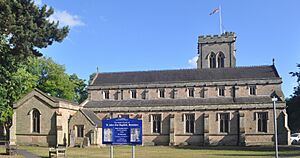St John the Baptist Church, Beeston facts for kids
Quick facts for kids St John the Baptist |
|
|---|---|

St John the Baptist, Beeston in June 2025
|
|
| 52°55′32″N 1°13′0″W / 52.92556°N 1.21667°W | |
| Location | Beeston, Nottinghamshire |
| Country | England |
| Denomination | Church of England |
| Churchmanship | Broad Church |
| Website | beestonparishchurch.com |
| History | |
| Dedication | St John the Baptist |
| Consecrated | 5 September 1844 |
| Architecture | |
| Heritage designation | Grade II listed |
| Architect(s) | George Gilbert Scott |
| Groundbreaking | 1842 |
| Completed | 1844 |
| Construction cost | £3,600 (£280,146 in 2021) |
| Specifications | |
| Length | 115.66 feet (35.25 m) |
| Width | 49.5 feet (15.1 m) |
| Nave width | 24.2 feet (7.4 m) |
| Height | 64 feet (20 m) |
| Administration | |
| Parish | Beeston |
| Deanery | Nottingham South |
| Archdeaconry | Nottingham |
| Diocese | Diocese of Southwell and Nottingham |
| Province | Province of York |
St. John the Baptist Church is an Anglican church located in Beeston, Nottinghamshire, England. It is a special building because it is listed as Grade II listed. This means it is important for its history or architecture.
Contents
History of the Church
This church is very old, from the Middle Ages. The chancel (the part where the altar is) is still the original one. However, most of the church was rebuilt and made new again in 1842. This work was done by famous architects George Gilbert Scott and William Bonython Moffatt. The church was officially opened and blessed on September 5, 1844, by the Bishop of Lincoln.
A special room for the organ was added in 1876 by architects Robert Evans and William Jolley. New furniture, like a stand for reading (lectern) and special seats for the choir (chancel stalls), were put in. Mr. Tattershall from London made the chancel stalls.
In 2007, the church had a big renovation that cost £860,000. The main entrance was moved to the west side. The inside of the church was cleaned, and new heating, seating, and a new organ were installed. The font, which is a basin used for baptisms, is also very old. It dates back to the time of King Henry III.
Church Organs and Music
The first organ known to be in the church was put in during 1854. It was made by Kirkland and Jardine of Manchester and cost £300. This money was raised by people donating to the church. The organ was placed on a special gallery. It was first played on Tuesday, April 25, 1854.
More parts were added to the organ in 1856. In 1876, it was made even bigger and better. It was then moved to the chancel after the gallery was taken down. The organ was fixed up again in 1903 and 1909 by Charles Lloyd of Nottingham. It had another repair in 1946.
In 1983, the old organ was removed and replaced with an electronic organ. This electronic organ was then replaced with an even newer one in 2008.
Organists of the Church
- Samuel Thornhill
- Frederick Kirkby (1862 – 1885)
- Norman Frederick Byng Johnson (1895 – 1903)
- Horace Vernon Kington (1903 – 1925)
- John Hammond Fearon (1925 – 1931)
- Stanley Nolan (1931 – 1935)
- Harold Allton (1936 – 1961)
- Michael Grantham (1961 – 1986)
- Philip Sherratt (2010 - 2022)
- Chris Warren (Director of Music) and Philip Miles (organist)
Images for kids
See also
- Listed buildings in Beeston, Nottinghamshire




